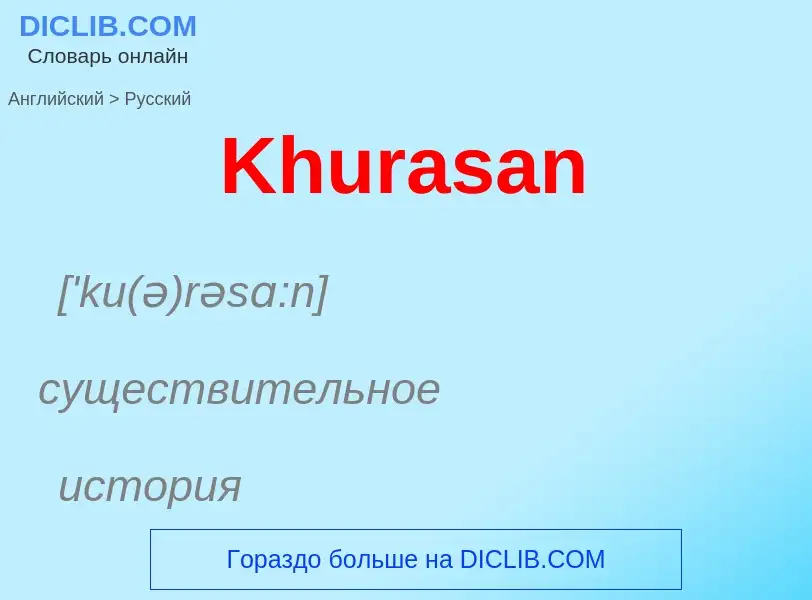Translation and analysis of words by ChatGPT artificial intelligence
On this page you can get a detailed analysis of a word or phrase, produced by the best artificial intelligence technology to date:
- how the word is used
- frequency of use
- it is used more often in oral or written speech
- word translation options
- usage examples (several phrases with translation)
- etymology
Khurasan - translation to russian
['ku(ə)rəsɑ:n]
существительное
история
Хорасан
Wikipedia

Greater Khorāsān, or Khorāsān (Middle Persian: Xwarāsān; Persian: خراسان [xoɾɒːˈsɒːn] (listen)), is a historical eastern region in the Iranian Plateau between Western and Central Asia. The name Khorāsān is Persian (from Bactrian Miirosan) meaning "where the sun arrives from" or "the Eastern Province". The name was first given to the eastern province of Persia during the Sasanian Empire and was used from the late Middle Ages in distinction to neighbouring Transoxiana. Greater Khorasan is today sometimes used to distinguish the larger historical region from the former Khorasan Province of Iran (1906–2004), which roughly encompassed the western half of the historical Greater Khorasan.
Khorasan comprised the present territories of northeastern Iran, parts of Afghanistan and southern parts of Central Asia. The province was often subdivided into four quarters, such that Nishapur (present-day Iran), Marv (present-day Turkmenistan), Herat and Balkh (present-day Afghanistan) were the centers, respectively, of the westernmost, northernmost, central, and easternmost quarters. In a strict sense of the term, Khorasan stretched as far as the Amu Darya (Oxus) river. However, the name has often been used in a loose sense to include a wider region that included most of Transoxiana (encompassing Bukhara and Samarqand in present-day Uzbekistan), extended westward to the Caspian coast and to the Dasht-e Kavir southward to Sistan, and eastward to the Pamir Mountains.
Khorasan was first established as an administrative division in the 6th century (approximately after 520) by the Sasanians, during the reign of Kavad I (r. 488–496, 498/9–531) or Khosrow I (r. 531–579), which comprised the eastern and northeastern part of the empire. The use of Bactrian Miirosan 'the east' as an administrative designation under Alkhan rulers in the same region is possibly the forerunner of the Sasanian administrative division of Khurasan, occurring after their takeover of Hephthalite territories south of the Oxus. The transformation of the term and its identification with a larger region is thus a development of the late Sasanian and early Islamic periods. Early Islamic usage often regarded everywhere east of Jibal or what was subsequently termed Iraq Ajami (Persian Iraq), as being included in a vast and loosely-defined region of Khorasan, which might even extend to the Indus Valley and the Pamir Mountains. The boundary between these two was the region surrounding the cities of Gurgan and Qumis. In particular, the Ghaznavids, Seljuqs and Timurids divided their empires into Iraqi and Khorasani regions. Khorasan is believed to have been bounded in the southwest by desert and the town of Tabas, known as "the Gate of Khorasan",: 562 from which it extended eastward to the mountains of central Afghanistan. Sources from the 10th century onwards refer to areas in the south of the Hindu Kush as the Khorasan Marches, forming a frontier region between Khorasan and Hindustan.


![Caliphate]] in 750 Caliphate]] in 750](https://commons.wikimedia.org/wiki/Special:FilePath/Ancient Khorasan highlighted.jpg?width=200)
![An 1886 map of the 10th century [[Near East]] showing Khorasan east of the province of [[Jibal]] An 1886 map of the 10th century [[Near East]] showing Khorasan east of the province of [[Jibal]]](https://commons.wikimedia.org/wiki/Special:FilePath/Lagekarte Dschibal.jpg?width=200)
![Madan]] village of Khorasan during the early 20th century Madan]] village of Khorasan during the early 20th century](https://commons.wikimedia.org/wiki/Special:FilePath/Madan Turquoise Mines.jpg?width=200)
![A map of Persia by [[Emanuel Bowen]] showing the names of territories during the Persian [[Safavid dynasty]] and [[Mughal Empire]] of India ({{circa}} 1500–1747) A map of Persia by [[Emanuel Bowen]] showing the names of territories during the Persian [[Safavid dynasty]] and [[Mughal Empire]] of India ({{circa}} 1500–1747)](https://commons.wikimedia.org/wiki/Special:FilePath/Map of Afghanistan during the Safavid and Moghul Empire.jpg?width=200)
![Madan]] in 1909 Madan]] in 1909](https://commons.wikimedia.org/wiki/Special:FilePath/Meyamei.jpg?width=200)
![Timurid]] conqueror [[Babur]] exiles his treacherous relative Muḥammad Ḥusaym Mīrzā to Khorasan. Timurid]] conqueror [[Babur]] exiles his treacherous relative Muḥammad Ḥusaym Mīrzā to Khorasan.](https://commons.wikimedia.org/wiki/Special:FilePath/Muḥammad Ḥusaym Mīrzā, a relative of Babur, in spite of his treachery, is being released and send to Khurāsān.jpg?width=200)
